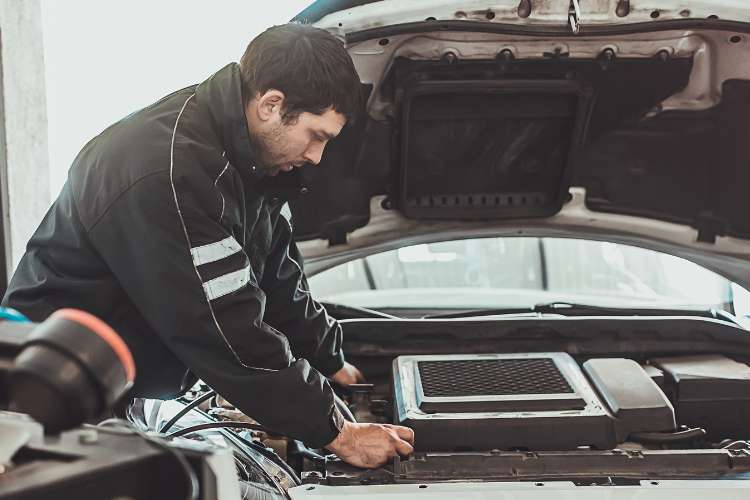Last Updated on June 19, 2023 by Henry T. Hawkins
As the weather heats up, there’s nothing quite like a cool blast of air conditioning to make your car ride comfortable. But what happens when your car’s AC is running but not cooling? This can be frustrating and uncomfortable, especially during long drives or hot summer days.
In this blog post, we’ll look at some of the most common reasons why your car’s AC might be running but not cooling and what you can do to fix it.

Why Is My Car Ac Running But Not Cooling?
When your car’s AC is running but not cooling, it can be a frustrating experience, especially during hot weather. There are several possible reasons why this might be happening.
Here are some potential causes and solutions:
Check the Compressor
The compressor is the heart of your car’s AC system. If it’s not working correctly, your AC won’t cool the air. Start by checking the compressor clutch, which is the centerpiece that engages the pulley to the compressor shaft. Listen for a “click” sound when the clutch turns on and off while the car is running.
A possible reason for the device not turning on could be a malfunctioning part, such as not receiving power.
If it’s kicking on and off rapidly, it might be a sign of a low refrigerant charge or a clogged expansion valve.
Check for Refrigerant Leaks
Low refrigerant levels can cause your AC to blow warm air. Refrigerant leaks can happen anywhere in the system, including the compressor, condenser, accumulator, and evaporator. You can detect leaks using an AC leak detection kit or by taking your car to a professional. Once you find and fix the leaks, recharge the system with the appropriate amount of refrigerant.
“It is important to check the system for any leaks or other issues before adding refrigerant. If not done properly, it can cause further damage and increase repair costs.” says Tim Miller, an Automotive Mechanic.
Check the Condenser and Evaporator
The condenser and evaporator are other components of the AC system that can cause problems. The condenser is responsible for releasing heat from the refrigerant, while the evaporator cools the air that passes over it. If these components are clogged or damaged, they can affect the cooling process. Clean or replace them as necessary.
Check the Electrical System
Electrical issues can also cause your AC to malfunction. Check the fuses, relays, and wiring to make sure everything is working correctly. A faulty AC pressure switch can prevent the compressor from turning on, while a bad blower motor can prevent the cool air from reaching the cabin.
Check for Blockages
Blockages in the system can also prevent the AC from cooling correctly. Check for debris or obstructions in the ducts, vents, or the cabin air filter. A dirty air filter can also reduce the airflow, making it harder for the AC to cool the air. Replace or clean the filter as necessary.
Other Possible Causes
Other possible causes for your car’s AC not cooling include a malfunctioning expansion valve or orifice tube, a dirty or blocked condenser, a malfunctioning temperature control switch, or a faulty compressor. If you’re unsure of the cause, it’s best to take your car to a professional for diagnosis and repair.
Also read: Why does my car shake more when I turn on the ac
What should I do when my car AC is blowing warm air?

When you turn on your car’s air conditioning system, and it blows warm air, it can be frustrating and uncomfortable. Fortunately, several potential causes can be identified to help you fix the problem.
Here are some troubleshooting steps to take:
Check the Refrigerant Level
The refrigerant is the substance responsible for cooling the air that blows through the AC system. The most common cause of warm air from an AC system is a lack of refrigerant. If there is not enough refrigerant in the system, the air won’t be cooled correctly.
To check the refrigerant level, you can use a refrigerant pressure gauge, which attaches to the low-pressure port of the AC system. If the level is low, you can refill the refrigerant.
However, if the level is low, it may indicate a leak in the system. Therefore, locating and repairing the leak is necessary to prevent the problem from reoccurring.
Inspect the Electrical System
A malfunction in the electrical system can also cause the AC to blow warm air. Issues such as a faulty AC compressor, broken cooling fans, or a blown fuse can be responsible.
To diagnose electrical problems, you can use a multimeter to check the voltage and continuity of various electrical components. If you find a faulty component, you should replace it to fix the problem.
Check the Cooling Fans
Cooling fans play a vital role in the functioning of the AC system. They help to cool the condenser and remove heat from the AC system. If the fans are not working correctly, they can cause the AC to blow warm air.
To check the fans, you can visually inspect them to ensure they’re spinning when the AC is on. If they’re not, you should replace them.
Inspect the Blend Door Actuator
The blend door actuator is responsible for controlling the airflow in the car’s AC system. A defective actuator can prevent air from flowing correctly, causing the AC to blow warm air.
To diagnose the problem, you can test the actuator by turning the temperature control knob from hot to cold while listening for a clicking sound. If you don’t hear a clicking sound, the actuator may be defective and need to be replaced.
Take it to a Mechanic.
Suppose you’re unable to identify the cause of the problem or don’t have the necessary tools or experience to fix the issue yourself. In that case, taking your car to a qualified mechanic is recommended.
A professional mechanic can diagnose and repair the problem for you, saving you time and money in the long run. They have the experience and tools necessary to identify the root cause of the problem and fix it efficiently.
Also read: Do You Need An Alignment After Replacing Sway Bar Links
Frequently Asked Questions
What are the symptoms of excessive AC pressure?
Signs of high air conditioning pressure can include noises from the compressor, slipping of the drive belt, and decreased cooling performance.
When the condenser experiences airflow obstruction caused by various factors such as paper, leaves, dust, debris, or bent cooling fins, it can increase refrigerant temperature and pressure.
How can I identify if the compressor is broken or not receiving power?
You can identify if the compressor is broken or not receiving power by locating the compressor under the hood, listening for the clutch “click” on and off while the car is running, and checking if it’s kicking on and off rapidly.
If the device fails to turn on, it could be due to a malfunction or lack of power supply. If the system is experiencing rapid cycling, it may be due to low refrigerant levels.
Where should I start diagnosing my car’s AC issue?
When diagnosing an air conditioning issue, it’s easiest to begin at the compressor. With the engine running, turn the A/C on to max cool, set the fans high, and ensure the clutch engages on the compressor. Note that this is not the pulley but the centre piece that engages the pulley to the compressor shaft.
How can I detect possible leaks causing the AC compressor to run but not cool?
To detect possible leaks causing the AC compressor to run but not cool, you can call a repairer or use AC leak detection kits available online. You should make sure all the fittings are intact and locate the front seal and the O-rings. If you are unsure, it is recommended to seek professional help.
Conclusion
If your car’s AC is running but not cooling, it can be a frustrating experience. But don’t worry; there are a number of possible reasons for this issue, and many of them are relatively easy to fix.
Whether it’s a simple problem with your air filter or a more complex issue with your compressor or refrigerant, it’s important to address the issue sooner rather than later.
By taking the time to diagnose and fix the problem, you’ll be able to enjoy a comfortable, cool ride no matter how hot it gets outside.
